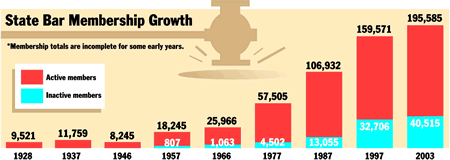

Better job market for attorneysThe ratio of lawyers in California per thousand people in the state now nearly approximates the national average following a decade in which California clearly had an oversupply of attorneys. That finding — a major conclusion drawn by RAND in an assessment of future workforce needs for California lawyers through the year 2015 — bodes well for employment of California attorneys following a turbulent few decades when the U.S. experienced an unprecedented explosion in the number of lawyers per capita, with California leading the way. Researchers note that by 1990, following the rapid expansion of the profession’s rolls in the preceding two decades, there was an acknowledged oversupply of attorneys, and a declining economy led many to exit the profession. The leveling off in the number of lawyers per thousand Californians tends to be accompanied by a leveling off in actual admissions to the State Bar of California over the past 16 years.
In 1987, 5,875 new lawyers were admitted to the State Bar, while in 2003 the number was 5,723. In between, new admittees reached a high of 6,657 in 1997 and a low for that period of 5,616 in 2002, as well as a virtually comparable 5,623 in 1991. Even with the leveling, the State Bar membership grew 82 percent over the 16 years, from 106,932 members in 1987 to 194,585 on Jan. 1 of this year. To confirm the explosion of the 1970s and ’80s, bar membership has grown a whopping 649 percent since 1966, when the California bar had 25,966 members, and an unfathomable 1,943 percent since 1928, when after its first year in existence the mandatory bar licensed 9,521 members. The RAND study concludes that the number of lawyers licensed is likely to keep pace with, or exceed the expected growth in demand, between 2003 and 2015, for California as a whole and each region in the state. The study, which was conducted at the request of the University of California to assess the need for a new law school in the state, defines supply as the number of qualified lawyers at a particular point in time willing to work under prevailing market wages. Similarly, demand is defined as the number of lawyers that employers or clients are willing and able to hire at the prevailing market wage. The research points to several trends that most likely will allow the market to avoid surplus and shortage. First, the labor market appears to have adapted to changing demand in the recent past through adjustments in wages and number of hours worked. Lawyers also are more able and willing to move in and out of the profession in response to changing demand, a fact evident at the bar as lawyers move from active to inactive status. Second, law schools currently do not expect to increase their enrollments in the coming decade, and third, law firms certainly are not expanding their hiring as rapidly as in the booming ’80s. These trends, along with an expected expansion in California’s economy that opens other alternatives to graduate school and/or law school, are expected, according to researchers, to maintain equilibrium between supply and demand. Some other major findings of the study:
The exhaustive study may be viewed in its entirety at http://www.rand.org/publications/MR/MR1710/. Specific numbers for the State Bar of California may be retrieved at the bar Web site in the section Bar Numbers. |
||||||||
|
||||||||
